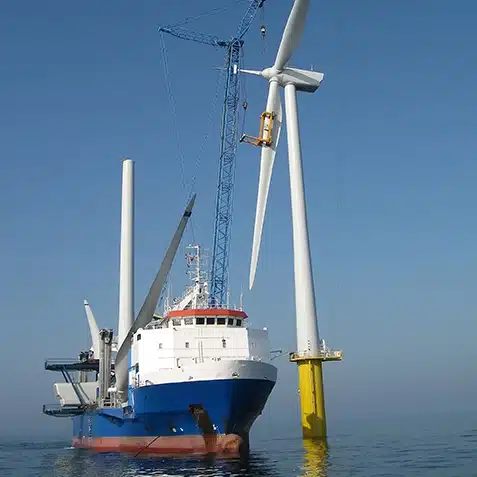Offshore Wind Energy Course
Diploma in Offshore Wind Energy
Offshore Wind Energy
This globally recognised offshore wind training course provides structured instruction in wind turbine systems, offshore installation procedures and renewable energy operations.
Designed for professionals entering or progressing within the offshore wind industry, the diploma covers turbine components, safety compliance, project planning, and maintenance operations across offshore wind farms. Study online and gain a formal qualification in one of the world’s fastest growing renewable energy sectors.

Professional Offshore Wind Energy Qualification
Train for a career in wind turbine operations, offshore maintenance or renewable energy project support. This course combines technical foundations with practical applications relevant to today’s offshore wind sector.
Contact us below to enrol today, or speak with our experienced course advisors.

Duration:
12 - 18 months
Learn at your own pace
Online Course:
Study from anywhere

Cost:
Diploma: £3,195
Certificate: £2,295

Recognised by: 
Offshore Wind Energy Diploma vs Certification
Choose the right path for your career:
Comprehensive Training: Turbine structure and systems, offshore installation, electrical safety, health and environmental standards, turbine access, GWO-aligned protocols and offshore maintenance plannin
Flexible Study Duration: 12 – 18 month depending when you enrol to the program, study online at your own pace, from anywhere in the world.
Marine Industry Career Opportunities: 100% Online, with access to our student learning portal
Long-Term Career Impact: Offshore Wind Technician, Installation Crew Member, Wind Energy Operations Assistant, Marine Project Coordinator, Wind Farm Maintenance Planner.
Global Recognition: Our Diplomas are recognised by the University of Portsmouth and are supported by industry associations.
Assignments: One assignment is required to be completed and submitted at the end of each module, based on that particular subject.
Certification: you will receive a PDF Digital certificate (Printed Certificate Completion Pack available).
Final Examination: There will be a final examination upon completing and submitting all student assignments (exams are sat in April or October).
Post-Nominal letters: On passing the Diploma you can also use these letters after your name: MTA Dip OffWind
Digital Course Badge: Upon successful completion students will receive an exclusive course badge for use on business cards, LinkedIn profiles and website(s)!
Diploma - £3,195
A professional qualification in offshore wind energy operations, designed for those pursuing technician, coordinator or engineering support roles within wind energy infrastructure.
✔
✔
✔
✔
✔
✔
✔
✔
✔
✔
Certificate - £2,295
Industry-focused training without assessment. Suitable for crew, operations staff or entry-level professionals seeking an introduction to offshore wind projects.
✔
✔
✔
✔
✔
✔
Offshore Wind Energy Curriculum: 8 Modules
This course provides a practical understanding of offshore wind farm operations — including turbine components, installation techniques, cable infrastructure, maintenance cycles and health and safety requirements.
Modules also cover energy conversion principles, regulatory frameworks, risk management and technician-level responsibilities. It’s designed for those entering the industry or cross-skilling from other marine or engineering backgrounds.
1. Wind Energy History and the Environment
- Wind Energy History
- Wind Energy and the Environment
- Oil Spill Impact and Response
- Offshore wind energy advantages and disadvantages
- Wind Energy Sustainability and Preventive Maintenance
- Future Offshore Wind Energy Trends
2. Offshore Wind Energy Layout, Equipment and Design
- Offshore Wind Energy Planning, Research, Design and Development
- Geotechnical and geophysical surveying and equipment
- Diving support
- Offshore Wind Energy Systems and Field Equipment Overview
- Wind Energy to Hydrogen
- Wind Turbine and Battery Storage
3. Remote Operated Vehicles (ROVs), Trenching and Electrical Cable Laying
- The electrical cable array overview
- Types of cable
- Cable trenching history
- Cable trenching techniques
- Trenching equipment
- Horizontal Directional Drilling
- The Scour Effect
- Alternative Cable Protection
- Cable Laying and the Cable Ships
- Cable Laying Procedural Overview
- Wind Turbine Cable Connection
- Remote operated vehicles (ROVs) and their application
- ROV launching and recovery system
4. Function and Operation of the Wind Turbine Installation Vessel (WTIV) and Support Vessels
- History of the WTIV
- Jack-up Jacking Systems
- Dynamic Positioning (DP) Operations Overview
- Propulsion Systems and Controls
- Offshore Cranes
- Jacking Operations
- Operation of Crew Transfer Vessels (CTVs)
- Miscellaneous Renewable Offshore Vessels
- Helicopter Operations
5. Turbine Operation and Ancillary Equipment
- The Wind Turbine and its Components
- Turbine Monitoring and Maintenance
- Wind Turbine Fire Protection
- Wind Turbine Installation
- Offshore Wind Turbine – Concepts
- Decommissioning
6. Electrical Systems and Substations
- Substation Overview
- Understanding Active and Reactive Power
- High Voltage Alternating Current (HVAC) Equipment
- High Voltage Direct Current (HVDC) Equipment
- Auxiliary Power and Control Systems
- Fire Protection and Emergency Shutdown (ESD) Systems
- Substation Installation, Monitoring and Maintenance
- Corrosion Protection Systems
7. Health and Safety for the Offshore Renewable Industries
- Offshore Lifting Regulations
- Offshore Renewable Crew Training
- Safety of Life at Sea (SOLAS) Regulations Overview
- Offshore Accident Investigation and Reporting
- Preservation and Safety of the Environment
- Material Safety Data Sheets (MSDS)
8. Introduction to Offshore Legislation and Governing Bodies Offshore Legislation and Regulation
- Offshore Legislation and Regulation
- Offshore Renewable Guidance
- Logistic Operations Offshore
- The Workboat Code
- National Workboat Association (NWA)
- Hazardous Areas
- US Jones Act
- The Supply Chain
- Simultaneous Operations (SIMOPS)
Hear from our Students
Meet the Course Director
Ian Bryant
Course Director at Maritime Services International
My career spans 40+ years from all operating stages to Chief Engineer on a variety of vessels which include cable laying ships and selfpropelled jack-ups.
More recently from 2002 I formed an independent offshore consultancy company carrying out a range of consultancy work including training/ competency for blue chip offshore oil and gas and renewable energy companies.
Other aspects of work include operations manuals for renewable offshore and shipping assets as well as Failure Mode Effect Critical Analysis (FMECAs) for well-known offshore companies.

Offshore Wind Energy Course FAQs
Find out more about the course with our FAQs below.
How do I become an offshore wind energy worker?
Begin by completing a recognised training course. This diploma provides the core operational and technical knowledge needed to start a career in offshore wind installation or support roles.
How much do offshore wind professionals earn?
Entry-level technicians typically earn between £30,000 and £40,000. Experienced engineers, coordinators or offshore specialists can earn £50,000 to £75,000+ depending on role and location.
What qualification will I receive?
You’ll receive a Diploma in Offshore Wind Energy from the Maritime Training Academy recognised across the renewable energy and marine operations sectors.
Does this course align with offshore turbine technician requirements?
It does – our course includes key topics relevant to offshore turbine work, including safety, maintenance and system operation in line with industry practices.
Is this training suitable for career changers or seafarers?
Absolutely. It’s designed for those transitioning from maritime, engineering or offshore support roles into the wind energy sector.
Can I complete this course online?
Yes, the full course is delivered online with tutor support, allowing flexible study from anywhere in the world.
See our FAQ page for more questions answered about MTA courses.
Supported by:


Why Choose The Maritime Training Academy?

Flexible
Online learning allows you to study in your own time, at your own pace from anywhere in the world. This saves on travel and classroom costs and allows you to fit your studies around your job and progress your career.

Supportive
While the nature of distance learning is independent study, we recognise the importance of support. Students can contact us at any time during their course for assistance and our team of industry experts are always on hand for advice.

Expertise
We have over 50 industry experts writing, developing and advising on our course material. We truly believe that allowing students to tap into their expertise and knowledge is of the utmost importance to fulfil your dream career.
If you would prefer to complete this as a classroom-based course, please contact us.
